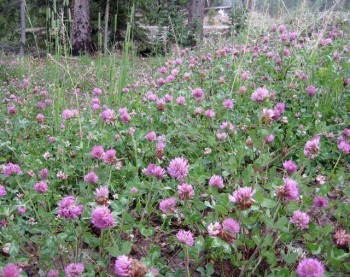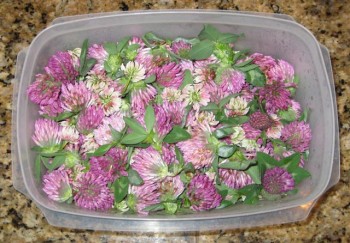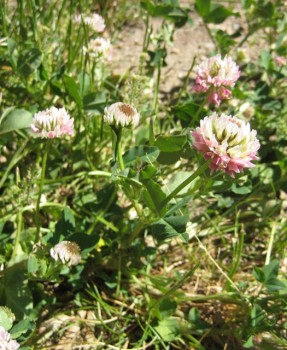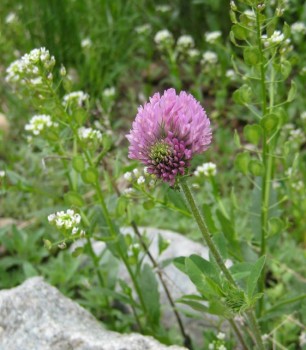
The come-down from my huge purslane processing of the other day has been harder than I imagined it would be, such that I have been remiss in processing the bag of plantain that Jim gifted me from Denver. I’ve been afraid to look but I fear it is decomposing in the refrigerator. I had some dandelion leaves in the fridge too—the ones that came attached to the roots I dug up for the purslane South Seas salad the other day. However, when I pulled them out yesterday to chop up and add to the salmon salad I was making, they were covered with disconcerting brown dots.
Compound these two unfortunate episodes with my less-than-successful experiences with red clover, and you get a somewhat disillusioned Wild Food Girl.
Here’s what happened with the clovers: We came home from our trip a week ago to find the side of the driveway, which last year was rife with pennycress, carpeted with beautiful red clovers in full bloom. Beneath those, a more subtle crop of small white clovers peeked out from behind the leaves of their larger cousins.

This was great news to me, especially because my recently acquired Edible Flowers: From Garden to Palate by Cathy Wilkinson Barash has an entire chapter on clovers, with recipes that call for a combination of the red and the white. I decided on two recipes—pickled clover flowers and clover soup—and soon harvested and cleaned enough of the large purple and small white-tinged-with-red blossoms for both recipes.
Pickled Clover Flowers
I regularly enjoy making sweet pickles with stonecrop flowers. Not only do they come out delicious, but they are also quite appealing to the eye. I was excited about the pickled clover flowers because I imagined the same would be true of them.
Not so much.
Here’s what I did: I put the clover flowers into a jar and poured in the correct proportion of honey and vinegar, then followed the instructions to “Cover with a cloth and let sit for a week before using.” Now, I refrigerate my sweet pickles, but the recipe did not direct me to put them in the refrigerator. Therefore, they are sitting in the corner of the kitchen with a cloth rubber-banded to the top which I occasionally remove in order to stir them because the clovers float and the ones on top are turning brownish in color.
It’s still a bit shy of the recommended week of waiting, but I ventured a taste today. Those pickled clover flowers are vinegary and yucky, never mind the fact that while a few remain purplish and the liquid has taken on a pretty pinkish color, many of the blossoms themselves are an unappealing gray-brown color. So, I can’t help but conclude, admittedly prematurely, that this dish is not a success.

Clover Soup
The clover soup recipe calls for sautéing the clovers in chive flower butter, which I did not happen to have on hand, so I sautéed them (without browning, as directed) in an oil-based butter spread. (Perhaps that was the problem?) Then I added potato cubes, ¼ cup tahini, and a cup of water and simmered for 40 minutes, longer than the recommended 20 to 30 so the potatoes would cook through. I sampled the broth while cooking and it tasted like watered-down tahini.
“For a thicker soup, puree half of the soup in a food processor or blender,” says Barash. That, at least, improved the texture.
“It tastes like it needs some spices,” Gregg said. Ok. I had just the thing. I ran a pint of pennycress (leaves and green seedpods) and wood sorrel through the food processor and dumped it in there. It improved the soup a lot, I thought, and Gregg agreed.
Still, while he said the taste grew on him and called it “subtle but interesting,” I just thought it was weird. Did I mention that I’m not altogether fond of tahini? (Perhaps that was the problem.)
Public Opinion Confirmed?
I’m having a traffic spike here at wildfoodgirl.com from retrievertraining.net, because a member of that forum posted a link to my article about cow parsnip (thanks for that, MooseGooser!) in order to make a distinction between it and a different plant—wild parsnip, an introduced invasive that, while containing an edible root, can also cause a nasty rash in conjunction with sunlight when touched. MooseGooser talks about cow parsnip a little himself before concluding, “I have tried to eat the shoots, but like most ‘EDIBLE’ plants, I find they don’t taste ANYTHING like chicken, but more like rotten grass!!”
If I weren’t leaning towards that conclusion already about the clovers, that would break my heart!

Most folks I’ve mentioned it to in real life think wild edibles a) will kill them, b) taste like dirt, or c) do not exist. I don’t want to think (or not think) these things; that’s why the clover experiments upset me so much, and led to this temporary pause in my obsession over wild edible plants.
Red Clover Tea = Good
Oh man, just as I was getting to this totally depressing conclusion, I realized that Gregg and I very much enjoyed a tea made with fresh red clover blossoms and yarrow leaves the other night. Does this mean that all is not lost after all, and that clovers may still have redemptive powers? One would hope that’s the case, on account of how pretty they are.
Caution:
By the way, if anyone out there reading this is planning to experiment with clover flowers, make sure to wash them well because we ended up with a little grit in the soup, which, like a glutton for punishment, I will now dine on in attempt to force myself to like it. If you are experimenting with clovers and you come up with something good, please, please feel motivated to share using the comment form below!

I know I just posted the above article, but after deciding to force myself to eat the rest of the clover flower soup, I doctored it by blending it completely and squeezing some lemon into it. Much better, if I do say so myself. I ate a whole bowl topped with parmesan cheese.